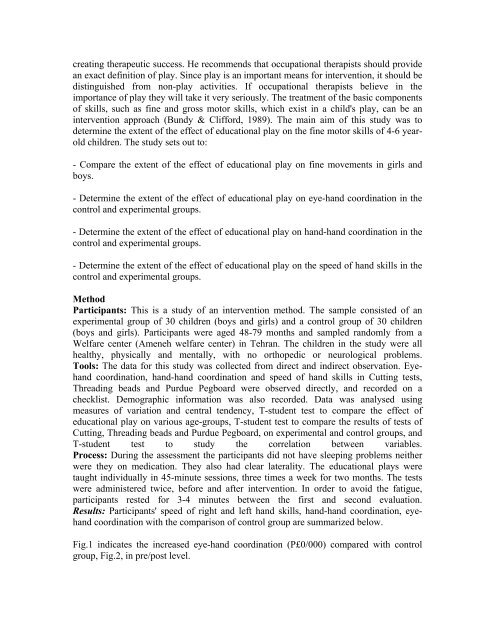THE IMPACT OF EDUCATIONAL PLAY ON FINE MOTOR SKILLS ...
THE IMPACT OF EDUCATIONAL PLAY ON FINE MOTOR SKILLS ...
THE IMPACT OF EDUCATIONAL PLAY ON FINE MOTOR SKILLS ...
Create successful ePaper yourself
Turn your PDF publications into a flip-book with our unique Google optimized e-Paper software.
creating therapeutic success. He recommends that occupational therapists should providean exact definition of play. Since play is an important means for intervention, it should bedistinguished from non-play activities. If occupational therapists believe in theimportance of play they will take it very seriously. The treatment of the basic componentsof skills, such as fine and gross motor skills, which exist in a child's play, can be anintervention approach (Bundy & Clifford, 1989). The main aim of this study was todetermine the extent of the effect of educational play on the fine motor skills of 4-6 yearoldchildren. The study sets out to:- Compare the extent of the effect of educational play on fine movements in girls andboys.- Determine the extent of the effect of educational play on eye-hand coordination in thecontrol and experimental groups.- Determine the extent of the effect of educational play on hand-hand coordination in thecontrol and experimental groups.- Determine the extent of the effect of educational play on the speed of hand skills in thecontrol and experimental groups.MethodParticipants: This is a study of an intervention method. The sample consisted of anexperimental group of 30 children (boys and girls) and a control group of 30 children(boys and girls). Participants were aged 48-79 months and sampled randomly from aWelfare center (Ameneh welfare center) in Tehran. The children in the study were allhealthy, physically and mentally, with no orthopedic or neurological problems.Tools: The data for this study was collected from direct and indirect observation. Eyehandcoordination, hand-hand coordination and speed of hand skills in Cutting tests,Threading beads and Purdue Pegboard were observed directly, and recorded on achecklist. Demographic information was also recorded. Data was analysed usingmeasures of variation and central tendency, T-student test to compare the effect ofeducational play on various age-groups, T-student test to compare the results of tests ofCutting, Threading beads and Purdue Pegboard, on experimental and control groups, andT-student test to study the correlation between variables.Process: During the assessment the participants did not have sleeping problems neitherwere they on medication. They also had clear laterality. The educational plays weretaught individually in 45-minute sessions, three times a week for two months. The testswere administered twice, before and after intervention. In order to avoid the fatigue,participants rested for 3-4 minutes between the first and second evaluation.Results: Participants' speed of right and left hand skills, hand-hand coordination, eyehandcoordination with the comparison of control group are summarized below.Fig.1 indicates the increased eye-hand coordination (P£0/000) compared with controlgroup, Fig.2, in pre/post level.
















